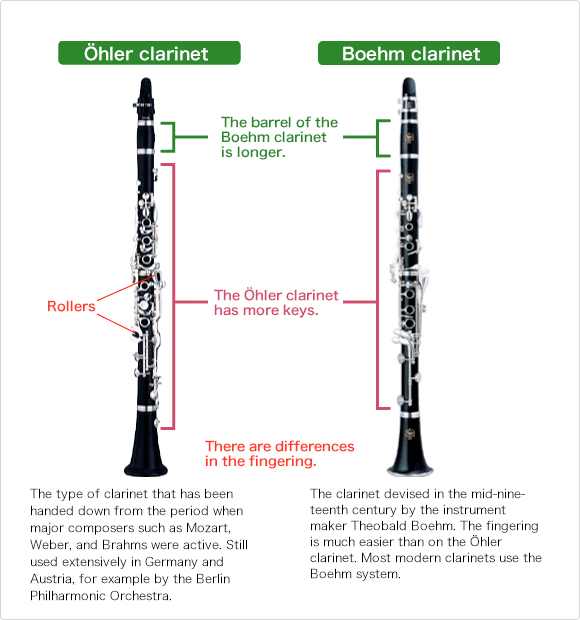The Structure of the Clarinet
[Experiment]The Boehm system and the Öhler system
From just two keys to 16
The clarinet is said to have been invented by Johann Denner around the turn of the eighteenth century. The clarinets that he constructed at his workshop only had two keys. Subsequently, the number of keys was gradually increased, and by the mid-nineteenth century clarinets virtually the same as those of today were being constructed with 16 keys, based on the ideas of Theobald Boehm, the flautist and son of a jeweler. This is the Boehm system, which has survived to this day.
What is a Boehm clarinet?
This is the type of clarinet devised in the mid-nineteenth century by the instrument maker Theobald Boehm. The fingering is much easier than on the Öhler clarinet. Most modern clarinets use the Boehm system.
The Boehm clarinet and the Öhler clarinet.

The traditional Öhler clarinet
This is the clarinet that has been handed down from the period when major composers such as Mozart, Weber, and Brahms were active. It is still used extensively in Germany and Austria.
In the era of Mozart and Beethoven, which was before the Boehm clarinet was invented, a forerunner of the Öhler clarinet predominated. The Vienna Philharmonic Orchestra and the Berlin Philharmonic Orchestra still use the Öhler clarinet today. Although the fingering on the Öhler clarinet is more difficult than on the Boehm clarinet, these orchestras set great store by its traditional sound.
The section for the little finger is different on the Öhler clarinet!
The keys for the little finger are of a flat design and have rollers attached to them to enable the little finger to glide over the keys more easily. Incidentally, the teardrop shape of the little-finger keys on the Boehm clarinet is a vestige of the Art Nouveau style which was in vogue around the turn of the twentieth century.
Musical Instrument Guide:Clarinet Contents
Structure
How the Instrument is Made
Choosing an Instrument
Trivia
- "I Broke My Clarinet" is a French folk song
- Inspiring composers
- In Italy, a single B♭ clarinet
- At one time, most clarinets were made of boxwood
- In vogue in the 1900s-the metal clarinet
- A transparent clarinet?
- Famous clarinet works: concertos
- Famous clarinet works: chamber music
- What is the relationship between hertz and cents?
